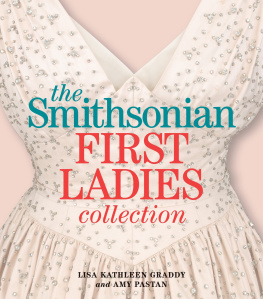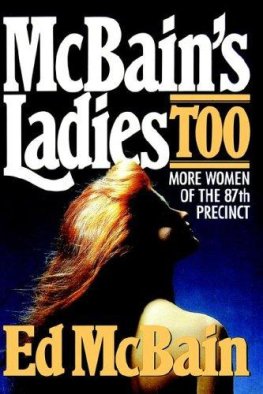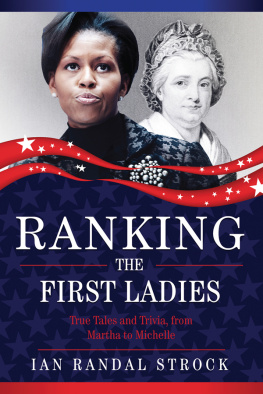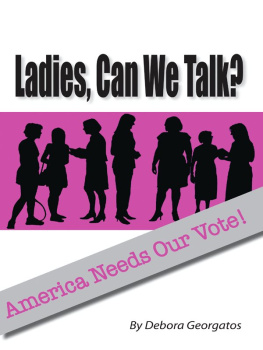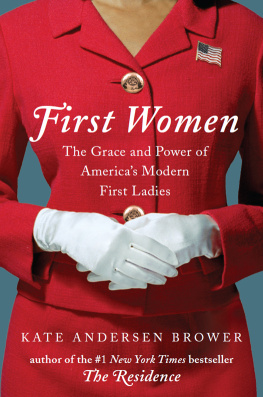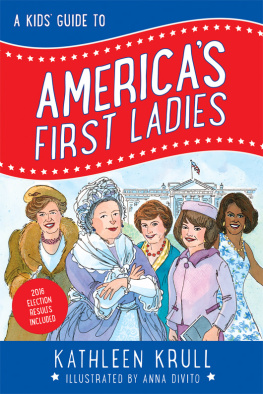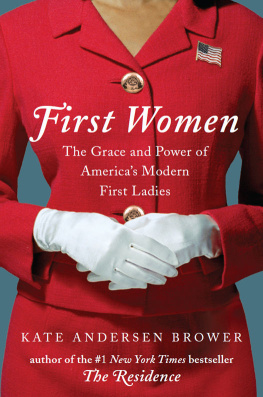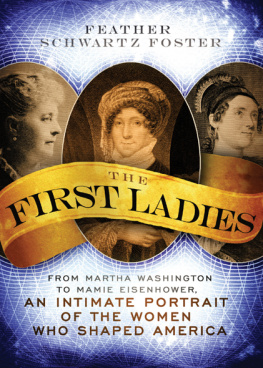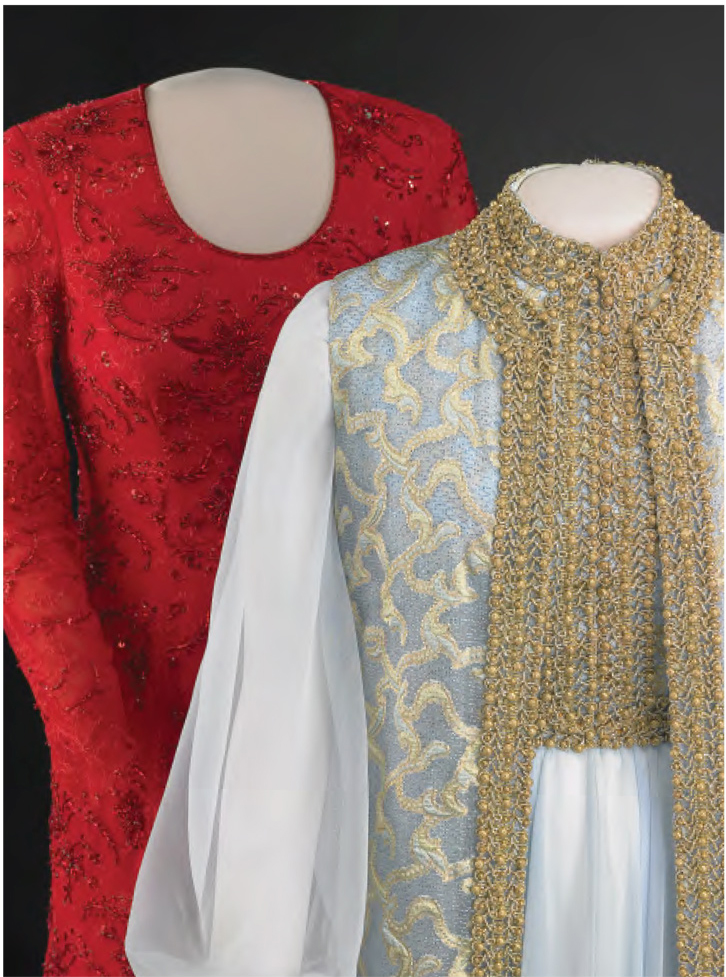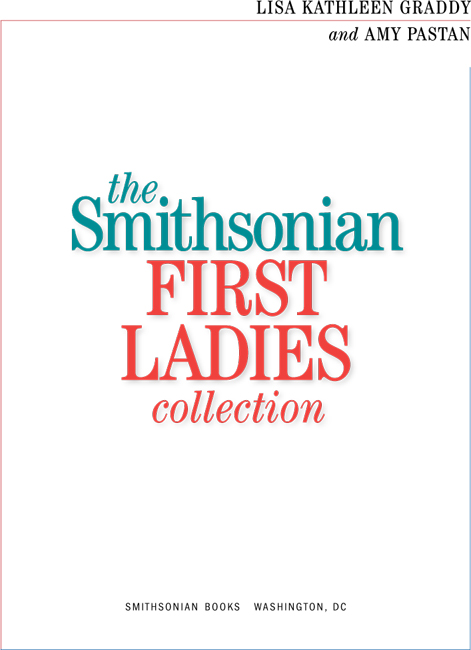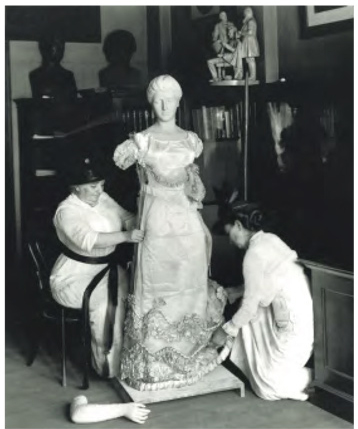Contents
Landmarks
Inaugural gowns worn by Laura Bush in 2001 (left) and Rosalynn Carter in 1977 (right).
COPYRIGHT
Text 2014 by Smithsonian Institution.
All rights reserved. No part of this publication may be reproduced or transmitted in any form or by any means, electronic or mechanical, including photocopying, recording, or information storage or retrieval system, without permission in writing from the publishers.
This book may be purchased for educational, business, or sales promotional use. For information, please write:
Special Markets Department
Smithsonian Books
P. O. Box 37012
MRC 513
Washington, DC 20013
Published by Smithsonian Books
Director: Carolyn Gleason
Editor: Christina Wiginton
Editorial Assistant: Ashley Montague
Text by Lisa Kathleen Graddy and Amy Pastan National Museum of American History staff: Bethanee Bemis, Larry Bird, Alicia Cutler, Debra Hashim, Marilyn Higgins, Patricia Mansfield, Sara Murphy, Jaclyn Nash, Harry Rubenstein, Hugh Talman, Richard Strauss
Edited by Nancy Eickel
Designed by Bill Anton | Service Station
Library of Congress Cataloging-in-Publication Data
Graddy, Lisa Kathleen.
The Smithsonian First Ladies Collection / Lisa Kathleen Graddy and Amy Pastan.
pages cm
ISBN 978-1-58834-469-4 (pbk.)
ISBN 978-1-58834-470-0 (ebook.)
1. Presidents spousesUnited StatesBiographyMiscellanea.
2. Presidents spousesUnited StatesHistoryExhibitions.
3. National Museum of American History (U.S.)Exhibitions.
I. Pastan, Amy. II. National Museum of American History (U.S.) III. Title.
E176.2.G73 2014
973.099dc23 2014000511
Manufactured in the United States of America
18 17 16 15 14 5 4 3 2 1
For permission to reproduce illustrations appearing in this book, please correspond directly with the owners of the works, as seen on this page. Smithsonian Books does not retain reproduction rights for these images individually, or maintain a file of addresses for sources.
FRONT COVER: Caroline Harrisons evening gown.
BACK COVER: (from left) Portrait of Martha Washington; Frances Clevelands wedding gown; Grace Coolidges evening dress; ERA button; Reagan White House china service plate, gift of the White House, negative number RWS2011-03493; Michelle Obama presenting her gown to the First Ladies Collection in March 2010.
rh_3.1_c0_r1
Caroline Harrisons evening gown.
CONTENTS
THE FIRST LADIES COLLECTION
by LISA KATHLEEN GRADDY, curator of the Smithsonian First Ladies Collection
THE FIRST LADIES COLLECTION
There was opened to the public on February 1, 1914, a collection of feminine import, which is quite unique for this country in its largeness of scope and in part at least for its method of presentation.
Annual Report of the National Museum, 1914
First ladies are unofficial but important members of presidential administrations. For more than two hundred years we have judged their clothes, their parties, their projects, and their roles and influence in the White House. While some duties, such as hostess of the Executive Mansion, are performed by all first ladies, the job does not come with a specific list of responsibilities. Over different times and circumstances, every first lady has fashioned her own way of handling the White House and families, parties, politics, and public scrutiny. Each has crafted significant roles for herself that she believed would allow her to suit her own interests, the needs of the presidential administration, and the publics changing expectations of women in general and first ladies in particular.
The Smithsonians First Ladies Collection weaves its famous gowns into a look at how these very different women have approached their undefined yet challenging position. This presentation is just the most recent incarnation of the beloved exhibition that has been one of the Smithsonians most popular attractions for more than a hundred years. Much like the women it presents, the exhibition has been repeatedly reimagined. Curators have experimented with new ways of expanding and interpreting the beloved collection to explore the mix of celebrity and achievement, fashion, and power that makes the history of the first ladies endlessly fascinating to visitors. The exhibition also addresses a question that has long puzzled Smithsonian staff: Why is there such interest in what the first ladies wear?
The idea for the collection began as a rainy day project more than a century ago. When dreary weather prevented Cassie Mason Myers Julian-James, a Washington society figure and museum enthusiast, from taking her ailing mother on their regular afternoon drive, they instead whiled away the afternoon by talking about a trunk filled with clothes and beautiful keepsakes that Mrs. Jamess grandmother had stored away in a New England attic. Mother and daughter decided they would each add a complete ensemble of their own to the trunk and create a small collection of womens fashion that spanned a century.
Cassie Mason Myers Julian-James (left) and Rose Gouverneur Hoes (right), the founders of the First Ladies Collection, dress a mannequin in a gown worn by Louisa Catherine Adams, 1916.
Mrs. James, a frequent donor to the Smithsonian, shared the story of her grandmothers trunk with museum staff, and they urged her to exhibit her collection there. She readily agreed and soon proposed expanding the small display into a larger exhibition of historic American clothing. The well-connected leader of Washington society turned volunteer curator began to solicit supportand clothesfrom her wide network of friends. Rose Gouverneur Hoes, the great-granddaughter of President James Monroe, contributed Monroe family relicsand an idea. Together Hoes and James developed a plan for a gallery of womens clothing featuring the costumes of the ladies of the White House.the time the exhibition, titled Collection of Period Costumes, made its public debut on February 1, 1914, Hoes and James had received gowns contributed by the friends and families of fifteen former first ladies.
The most important yes came from Helen Taft, who was then first lady. In 1912 she contributed the gown she had worn to her husbands inaugural ball three years earlier. Her enthusiastic support of the exhibition, coupled with its immediate popularity, prompted others to loan or donate missing gowns. This encouraged James to believe the exhibition would continue to grow, giving the public a most valuable collection of historic costumes of the great women of our country of whom we are so justly proud. Indeed, Mrs. Tafts donation established a precedent for future first ladies. Since that time, each first lady who attended an inaugural ball for her husband has donated the gown she wore to the event.
The cases featuring the first ladies gowns quickly became one of the museums most popular attractions. Women crowded the new exhibition, fascinated by the beautiful clothes and the inclusion of the first ladies as role models and historical figures. The collection expanded as more donations of memorabilia arrived and as the gown of each outgoing first lady was added to the display. In 1931 the exhibition moved to a more spacious gallery on the other side of the hall, where the collections illustrating Power, assembled by the division of mechanical technology, are proving an attraction for the male visitors, offsetting the feminine display on the right. The new presentation may have been beautiful and genteel, but woman power was competing with mechanical power in its ability to attract visitors.

